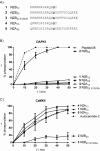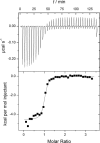Identification and characterization of a small-molecule inhibitor of death-associated protein kinase 1
- PMID: 25382253
- PMCID: PMC4431585
- DOI: 10.1002/cbic.201402512
Identification and characterization of a small-molecule inhibitor of death-associated protein kinase 1
Keywords: drug discovery; enzymes; inhibitors; phosphorylation; protein structures.
Figures





References
Publication types
MeSH terms
Substances
Grants and funding
LinkOut - more resources
Full Text Sources
Other Literature Sources

